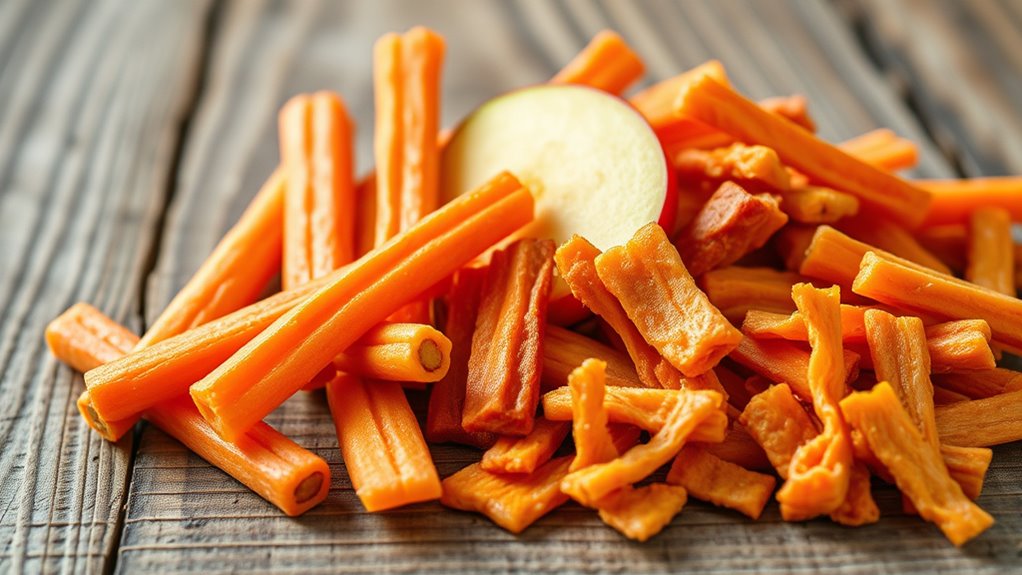Looking for low-calorie dog snacks that still taste great? You can choose from homemade treats made with fresh ingredients like carrots or apples, offering control over calories and flavor. Commercial options also work well—they’re convenient, tasty, and often formulated for weight management. Remember to select treats with wholesome ingredients and give them in moderation. To keep your dog happy and healthy, explore more tips on choosing tasty, low-calorie snacks that fit your pet’s needs.
Key Takeaways
- Opt for homemade treats using fresh, flavorful ingredients like carrots or apple slices to ensure low calories and great taste.
- Choose commercial low-calorie treats formulated with lean meats or vegetables for convenience and flavor.
- Incorporate your dog’s favorite flavors or textures into treats to enhance acceptance without added calories.
- Use a variety of both homemade and store-bought treats to keep rewards interesting and satisfying.
- Always consider your dog’s preferences and consult your vet for portion sizes to maintain taste and health benefits.

If you’re looking to keep your dog healthy and maintain a balanced weight, incorporating low-calorie snacks into their diet can be a smart choice. These treats can satisfy their craving for something tasty without adding unnecessary calories. You have the option to prepare homemade treats, which allows you to control the ingredients and keep the calorie count low. Simple recipes often involve ingredients like carrots, green beans, or apple slices—just make sure to cut them into manageable pieces and avoid any harmful additives or seasonings. Homemade treats are satisfying for your dog and can be customized to their taste preferences, making them a great alternative to store-bought options.
Homemade low-calorie dog treats with fresh ingredients like carrots and green beans are healthy and fun to make.
On the other hand, commercial brands offer a convenient and consistent way to reward your dog with low-calorie snacks. Many companies now produce treats specifically designed to be low in calories, using ingredients like lean meats, vegetables, or fruit extracts. When choosing commercial brands, read the labels carefully to ensure they don’t contain fillers, artificial preservatives, or excessive sodium. Opting for treats that are labeled as low-calorie or weight management can help you stick to your goals without sacrificing flavor or quality. These treats are often formulated to be both tasty and healthy, making them suitable for daily rewards or training sessions.
You might find that some dogs prefer the taste of homemade treats, especially if you incorporate their favorite flavors or textures. Plus, making your own snacks can be a fun activity and allows you to experiment with different ingredients to find what your dog loves most. If you’re pressed for time, many commercial brands offer a variety of low-calorie options that are easy to store and serve. Just remember, moderation is key. Even low-calorie treats should be given in small quantities to prevent overfeeding, which can lead to weight gain.
In addition, choosing treats with carefully selected ingredients can help ensure they are both healthy and appealing to your dog. Incorporating both homemade treats and commercial brands into your dog’s diet provides flexibility and variety. You get the benefit of knowing exactly what goes into homemade snacks, and you can always have a backup with store-bought options. Whether you choose to whip up your own low-calorie snacks or pick up some from a trusted brand, your dog will appreciate the effort and enjoy the tasty rewards. Always consider your dog’s specific dietary needs and consult your veterinarian if you’re unsure about portion sizes or ingredient choices. Ultimately, with a thoughtful approach, you can keep your dog happy, healthy, and satisfied with treats that taste great but don’t sabotage their health.
Frequently Asked Questions
Are Low-Calorie Dog Snacks Suitable for All Breeds?
Yes, low-calorie dog snacks can be suitable for all breeds, but you should consider breed considerations and dietary restrictions. Some breeds may need more calories or specific nutrients, so check with your vet before offering these treats. Always read ingredient labels to verify the snacks meet your dog’s dietary restrictions. Tailoring snacks to your dog’s size and health needs helps keep them safe and happy while enjoying tasty, low-calorie options.
How Often Can I Give My Dog Low-Calorie Treats?
You can give your dog low-calorie treats daily, but moderation is key—think of it as a treat treasure chest, not a never-ending buffet. Usually, giving treats once or twice a day is safe, especially with seasonal flavors that keep things exciting. Keep treat frequency balanced with their diet and activity level, ensuring your pup stays happy and healthy without overindulgence.
Can Low-Calorie Snacks Replace Regular Meals?
No, low-calorie snacks shouldn’t replace regular meals. They lack the nutritional adequacy your dog needs to stay healthy and can’t serve as meal replacements. Use them as treats or supplements, not substitutes. You need to make certain your dog gets a balanced diet with all essential nutrients, which snacks alone can’t provide. Stick to regular, complete meals for their main nutrition, and offer low-calorie treats in moderation.
Are Homemade Low-Calorie Snacks Safe for Dogs?
Yes, homemade low-calorie snacks can be safe for dogs if you use wholesome ingredients and follow proper storage safety. Always choose natural, dog-friendly ingredients like carrots, green beans, or apples, avoiding harmful foods like grapes or onions. Store the snacks in airtight containers and refrigerate or freeze them to prevent spoilage. Before offering homemade treats regularly, consult your vet to ensure they meet your dog’s dietary needs and safety standards.
Do Low-Calorie Treats Help With Weight Management?
Yes, low-calorie treats can help with weight management. When you incorporate calorie counting into your dog’s diet, it makes controlling their intake easier. Feeding these treats allows you to reward your dog without exceeding their daily calorie limit, aiding in weight control. Just make certain you choose healthy, portion-controlled snacks and balance them with regular exercise for the best results.
Conclusion
With these low-calorie dog snacks, you can imagine your furry friend happily wagging their tail, their eyes bright with excitement as they savor each tasty bite. Picture them lounging contentedly on the couch, feeling energized and healthy. These treats offer a perfect balance—delicious enough to satisfy their cravings while keeping their waistline in check. So, choose wisely and watch your pup enjoy guilt-free snacking, filling your home with wagging tails and happy, satisfied paws.










